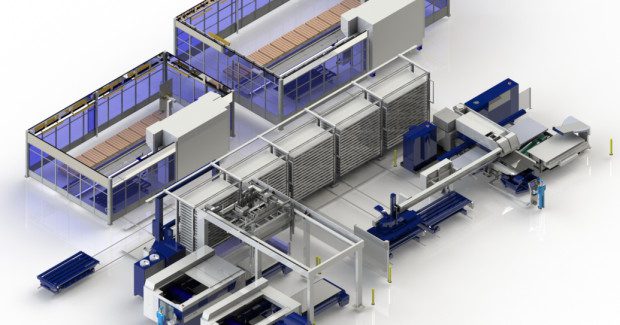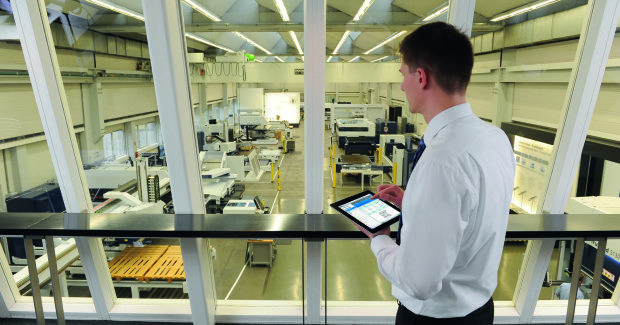Approaching Industry 4.0
A revolution is about to happen in the sheet metal business that will change the way fabricators compete – whether they are prepared for it or not. It’s time to research the strategic impact of automation in your shop, along with the related personnel, training and suppliers that you will need to make it meet your goals. This is going to determine your competitive position in the global market. Are you ready?
Posted: July 30, 2014
Technology continues to provide manufacturers with new means to communicate, integrate, and connect their processes. Today, the interdependence of technology is paramount to the success of sheet metal fabricators. Every day, new smart devices and application tools are created to make sheet metal fabrication shops more efficient. Connectivity with production processes is on the rise. Soon, production machinery and factory automation will send real-time production data to mobile devices as we approach Industry 4.0.
What exactly is Industry 4.0? Nothing less than the fourth industrial revolution.
Think about it. The development of steam power and shaft driven factories in the U.S. and Europe spawned the first industrial revolution. Industry 2.0 occurred shortly after that, as electrical power and the concept of mass production boosted productivity in manufacturing. The Internet and the digital age created the next revolution, where programmable controls and CNC machines allowed fabricators to produce parts precisely and at significantly higher rates while IT systems provided communication platforms to move information at lightning speed.
Up next: Industry 4.0 will reveal Cyber-Physical Production Systems and fully integrated manufacturing facilities. These CPS systems will be based on real-time, wireless connectivity that allows plants to be seamlessly managed and coordinated for automated order processing.
Factories will have a constant stream of production data and maintenance information. Operations managers will use mobile devices to monitor plant efficiencies, production constraints and planning. All of this requires “horizontal” integration, meaning automation for loading and unloading and its ability to link to business IT systems will become even more critical.
Machine tool suppliers are positioning themselves for Industry 4.0 and are able to supply end users with fully automated manufacturing solutions. Material storage and retrieval, machine loading and unloading, material processing and automated forming are all available today. Machine manufacturers are starting to implement smarter controls that are prepared for Internet integration, yet ways to tie the entire operation together are still being developed by controls manufacturers.
In the meantime, sheet metal fabricators should be aware of their coming needs and ask questions of suppliers about their readiness for Industry 4.0. Look for a supplier with a full line of machines, automation devices and the technical expertise to provide support programs for your employees and build a mutual understanding about what is needed versus what is possible.
To prepare for this revolution, a fabricator should also think about their business needs as well as the platforms, protocols and suppliers that can support them. This includes strategic partners who can deliver smart machines and the knowledge of how to integrate flexible unit operations that will bring factories to the next level. Fabricators should also consider the capabilities of their machines beyond part processing.
When looking for new equipment, consider what additional benefits can be achieved from investment in upstream and downstream smart automation, and begin to think about how each operation will become a part of the larger plan. Also look to develop knowledgeable employees who understand how to run a machine as well as how it will connect to higher IT and cyber-based platforms.
Be cognizant of current processes and begin to think about where one might make a smart investment in smart technology. This means an investment that is expandable and scalable for future growth to help capture new customers. The race will intensify as manufacturers migrate to compete, not just in part quality, but also with the pressure of per-part pricing that is possible with fully automated sheet metal manufacturing facilities.
Industry 4.0 will see integrations with host systems that eventually enable fully automated manufacturing and lights-out facilities to become the norm. Orders will be placed electronically and fully automated systems will execute orders from raw material to shipping. For this to run smoothly, part orientation and part tracking is critical. Today, scanning technologies exist for following parts down the production line, confirming percentage of completion and realigning parts as needed for processing.
As progress continues, raw materials placed into an automated storage system will be managed by a host system for real-time inventory data. As orders are placed, raw materials will be pulled into the appropriate machines, preloaded with part programs and sheet metal parts will be cut, punched and processed as needed. Parts will travel automatically to secondary processing while inventory systems continuously monitor part progress through the factory.
Part scanners will locate the parts and the robots and automated systems will use this information to make needed adjustments for downstream processing. Line tracking systems will make all production processes move at rates that maximize the efficiency of the plant. Once complete, the finished parts will be staged for shipping with customer and order information. Minimal human intervention will be required.
As we approach Industry 4.0, begin researching what is best for your business. Be pragmatic in your approach and set a long-term plan for continuous and selective investment into building blocks that help you reach your goals. Evaluate the impact of automation and be prepared with the needed personnel, with the appropriate training, to support new technology. Find those suppliers that have the resources to deliver against your needs and work closely with the technical departments of the suppliers.
Industry 4.0 is approaching. How you choose to implement its opportunities will determine your competitive position in the global market.






